Ohrdruf sub-camp of BuchenwaldPrevious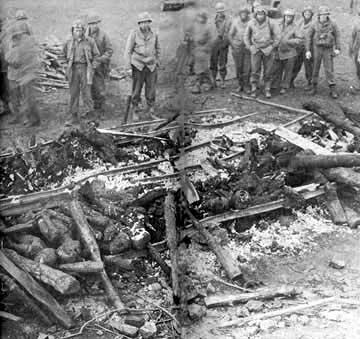 The photograph above, which was taken at the Ohrdruf forced labor camp, is a copy of the one that hangs in front of the elevator door at the US Holocaust Memorial Museum in Washington, DC. It is the first thing that visitors to the Museum see as they step out of the elevator and enter the first exhibit room. This is what the American soldiers first saw when they liberated Germany from the Nazis. The photo shows a pyre made of railroad tracks where the bodies of prisoners who had died at Ohrdruf were burned. Ohrdruf was a small sub-camp of Buchenwald and it did not have a crematorium with ovens to dispose of the bodies. 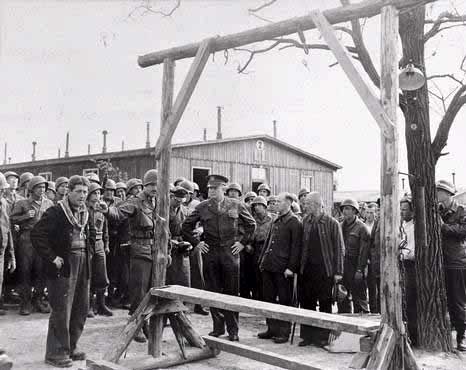 The photo above shows General Dwight D. Eisenhower viewing the gallows at Ohrdruf. Standing to the left of the general, and partially hidden by a pole, is Captain Alois Liethen, who was General Eisenhower's interpreter. The two men on Eisenhower's right are survivors who are explaining the atrocities committed in the camp. The Ohrdruf camp was unique in that prisoners were hanged there with piano wire, rather than with rope, according to the survivors. An identical gallows was found at the Buchenwald main camp, where prisoners were hanged with rope. The man on the far left, wearing a jacket and a scarf, is one of the survivors who served as a guide for General Eisenhower and his entourage. The next day the guide was "killed by some of the inmates," General Patton wrote in his memoirs, explaining that the guide "was not a prisoner at all, but one of the executioners." A. C. Boyd, a soldier in the 89th Infantry Division was at Ohrdruf on the day that this man was killed. In a news article in The Gadsden Times, Jimmy Smothers wrote the following: Boyd said he saw a Nazi guard, who had not fled with the others, trying to exit the camp. One of the prisoners, who still had a little strength, ran to a truck, got a tire iron and killed him. "I witnessed that and saw that no one tried to stop him," Boyd said. In a letter dated April 15, 1945, addressed to Ike (General Dwight D. Eisenhower), Patton wrote the following regarding the man who had served as their guide at Ohrdruf: It may interest you to know that the very talkative, alleged former member of the murder camp was recognized by a Russian prisoner as a former guard. The prisoner beat his brains out with a rock. This prisoner was probably one of the Kapos in the camp whose job had been to assist the German guards; it is doubtful that an SS soldier would have remained behind when the camp was evacuated, knowing that the prisoners would exact revenge as soon as the Americans arrived. If any SS men had remained in the camp, they would have been promptly killed or taken into custody on April 4, 1945 when the camp was first discovered by American troops. It has been alleged that some of the SS men at the concenration camps tried to disguise themselves by putting on civilian clothes or prison garb when the American troops approached, but the prisoners beat them to death after the camps were liberated. Note that General Patton referred to Ohrdruf as a "murder camp" in his letter. It is clear from Patton's letters and his memoir that he did not have a clear understanding of the purpose of the concentration camps and labor camps because he believed everything that the prisoners told him. Captain Alois Liethen also believed the stories told by the survivors, for example, the allegation that prisoners at Ohrdruf were whipped for the slightest infraction of the rules, although in 1942, long before the Ohrdruf camp was in existence, Reichsführer-SS Heinrich Himmler had forbidden the SS men to strike the prisoners. Captain Alois Liethen wrote the following in a letter to his family, dated 13 April 1945, the day after he served as the interpreter on the tour of Ohrdruf: The treatment of the prisoners was something that even amazed me. If anyone dared to even as much as smile in ranks he received 25 lashes with a heavy oak staff while he was bent over nearly double over a whipping post, anyone who tried to escape was hanged -- not by a rope but by a wire from a gibbet -- all of the inmates had to witness these hangings even tho they were sick or feeble. When they were out on a work detail -- which they were every day from daylight to darkness they were beaten if they didn't produce as fast as they should, and then in many cases when the whims of the guards arose to the occasion they would shoot at them just for the pure fun of it -- those that ducked were surely doomed for then they were a sure target for the second shot. Then to come to the matter of food. Each man received 300 grams of bread (black sour hard stuff) and 1 liter of soup, of course there were those who performed those special duties such as the one that I spoke to mostly -- he was on the burning and burying detail -- he got 500 grams of bread and 2 liters of soup perday (sic). They were kept very busy for there were estimated that there were 200 to 250 buried or burned every week. In the photo below, note the guide, in the center of the picture, who is walking beside the generals, telling them about the atrocities in the camp. This is the man who was killed by the other survivors the next day, according to General Patton. The man who is leading the walk around the bodies is Captain Liethen, the interpreter for the group.  The Ohrdruf-Nord camp had been discovered by the 4th Armored Division more than a week before the generals' visit, but everything had been left intact because General Walker and General Middleton had ordered that as many soldiers as possible should be brought there to view the horrible scene. The bodies were left out until at least the first week of May, so that visiting soldiers could pose beside them. 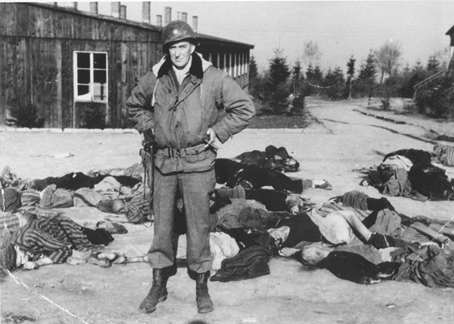 The photo below shows the townspeople from Ohrdruf as they are forced to view the bodies found in the camp. General Walker had ordered that the mayor of Ohrdruf and his wife should be brought to the camp to see the display of corpses. After seeing the horror, they went back home and killed themselves. 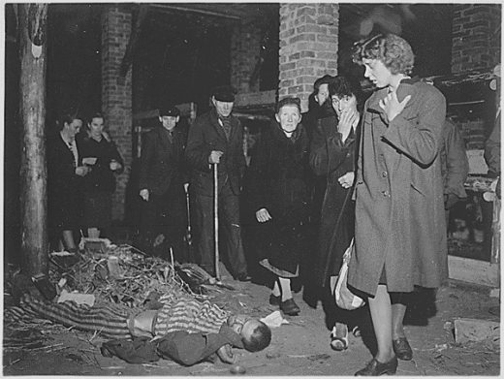 General Patton wrote that he suggested that the rest of the inhabitants of Ohrdruf be brought to the camp the next day, and that the army had "used the same system in having the inhabitants of Weimar go through the even larger slave camp (Buchenwald) north of that town." German civilians were brought from the town of Ohrdruf to exhume the bodies in the mass grave and bury them again in individual graves. 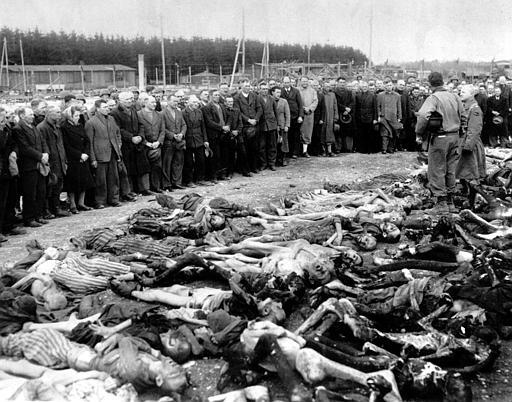 Regarding the Ohrdruf-Nord camp, General Patton wrote the following in his diary: It was the most appalling sight imaginable. In a shed . . . was a pile of about 40 completely naked human bodies in the last stages of emaciation. These bodies were lightly sprinkled with lime, not for the purposes of destroying them, but for the purpose of removing the stench. When the shed was full--I presume its capacity to be about 200, the bodies were taken to a pit a mile from the camp where they were buried. The inmates claimed that 3,000 men, who had been either shot in the head or who had died of starvation, had been so buried since the 1st of January. A typhus epidemic had started in Germany in December 1944 and had quickly spread to all the camps as prisoners were transferred from one camp to another. Half of all the prisoners who died in the German camps died between December 1944 and the end of June 1945. Yet the survivors of Ohrdruf claimed that all the bodies found at the camp were those of prisoners who had been deliberately killed or starved to death. It would be hard to find a German town, however small or obscure, that is completely lacking in historic or cultural importance. After describing the crimes of the Germans in his autobiography, General Patton went on to tell about how the Americans wantonly destroyed every village and hamlet in their path. On the same page of his book, in which he describes the atrocities of the Germans, Patton wrote the following: We developed later a system known as the 'Third Army War Memorial Project' by which we always fired a few salvos into every town we approached, before even asking for surrender. The object of this was to let the inhabitants have something to show to future generations of Germans by way of proof that the Third Army had passed that way. Robert Abzug wrote the following in his book entitled "Inside the Vicious Heart": Soon after seeing Ohrdruf, Eisenhower ordered every unit near by that was not in the front lines to tour Ohrdruf: "We are told that the American soldier does not know what he is fighting for. Now, at least, he will know what he is fighting against.'" Eisenhower felt it was essential not only for his troops to see for themselves, but for the world to know about conditions at Ohrdruf and other camps. From Third Army headquarters, he cabled London and Washington, urging delegations of officials and newsmen to be eye-witnesses to the camps. The message to Washington read: 'We are constantly finding German camps in which they have placed political prisoners where unspeakable conditions exist. From my own personal observation, I can state unequivocally that all written statements up to now do not paint the full horrors." The following quote is from an article copyrighted in 2004 on the Eisenhower Memorial Commission web site www.eisenhowermemorial.org/stories/death-camps.htm As Supreme Commander of the Allied Expeditionary Forces in World War II, General Eisenhower had been given information about the Nazi concentration camp system well before he led the invasion to liberate Western Europe (June, 1944). Reports on the massive genocide inflicted on Jews, Gypsies, political prisoners, homosexuals, dissidents, and other groups by the Schutzstaffel (SS) had been circulated among all the Allied leaders. Very few of the Allied commanders, however, had an accurate conception of what is now known to the world as the Holocaust until their troops began to encounter the death camps as they marched into Western Germany. On April 4, 1945, elements of the United States Army's 89th Infantry Division and the 4th Armored Division captured the Ohrdruf concentration camp outside the town of Gotha in south central Germany. Although the Americans didn't know it at the time, Ohrdruf was one of several sub-camps serving the Buchenwald extermination camp, which was close to the city of Weimar several miles north of Gotha. Ohrdruf was a holding facility for over 11,000 prisoners on their way to the gas chambers and crematoria at Buchenwald. Contrary to the information given by the Eisenhower Memorial Commision, which is quoted above, Ohrdruf was a forced labor camp, not "a holding facility" for prisoners on the way to the gas chambers. Buchenwald was one of the few camps in the Nazi system that did not have a gas chamber. Buchenwald gas chambr?Ohrdruf, ContinuedPreviousBuchenwald main campHomeThis page was last updated on May 5, 2009 |